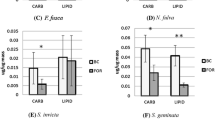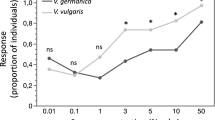Abstract
Social insects commonly exhibit division of labor in non-reproductive tasks. Task allocation may be related to size, form, and ergonomic differences when workers are anatomically variable. Carpenter ants Camponotus mus collecting nectar exhibit a wide forager size variation, thus raising the question of whether large and minor workers differ in their gustatory responsiveness and specialize, therefore, on different nectar sources. To answer this question, we first established the sucrose concentration at which small and large ants in the laboratory respond appetitively to a sugar solution (sucrose acceptance threshold, SAT) after experiencing a high or a low starvation regime (4- or 1-day carbohydrate deprivation, respectively). Under high starvation, no differences in SATs were found between larger and smaller ants. Under low starvation, both sizes increased their SATs but larger ants had a higher SAT, thus preferring more concentrated solutions while smaller ants responded mostly to more diluted sucrose solutions. In a field assay in which the distribution of larger and smaller ants on sugary food sources was analyzed, small and medium ants were found—in different proportions—at all food sources while larger ants were only found at nectar sources with a higher sugar flow rate, i.e., providing more sugar per unit time. Both field and laboratory assays supported that sugar-related parameters act as determinants of the size distribution of ants among food sources. In addition, interindividual differences in alternative non-sugar-related variables may contribute to this distribution, leading thereby to a potential nectar foraging specialization.
Significance statement
Task specialization is crucial for the ecological success of social insects. Carpenter ants allocate individuals of variable size to foraging, thus raising the question of whether they differ in their food preferences. We determined the sugar concentration at which an appetitive response occurs in small and large carpenter ants, and analyzed their distribution on natural and artificial nectar sources in a field assay. Under low starvation, larger ants responded more than smaller ants to higher sucrose concentrations. Coincidently, in the field assay, they were mainly present at sources with higher sucrose delivery. This kind of specialization may reflect the fact that larger ants have larger feeding apparatuses, which may confer a better capacity to deal with the higher viscosity of more concentrated nectars and allow collecting more food at nectaries with higher sugar flow rates. Size specialization may thus increase colony success in the exploitation of variable food sources.


Similar content being viewed by others
References
Baracchi D, Devaud JM, d’Ettorre P, Giurfa M (2017) Pheromones modulate reward responsiveness and non-associative learning in honey bees. Sci Rep 7:9875
Beckers R, Deneubourg JL, Goss S (1993) Modulation of trail laying in the ant Lasius niger (Hymenoptera, Formicidae) and its role in the collective selection of a food source. J Insect Behav 6:751–759
Benard J, Stach S, Giurfa M (2006) Categorization of visual stimuli in the honeybee Apis mellifera. Anim Cogn 9:257–270
Beshers SN, Fewell JH (2001) Models of division of labor in social insects. Annu Rev Entomol 46:413–440
Boggs CL (1988) Rates of nectar feeding in butterflies: effects of sex, size, age and nectar concentration. Funct Ecol 2:289–295
Cassill D (2003) Rules of supply and demand regulate recruitment to food in an ant society. Behav Ecol Sociobiol 54:441–450
Davidson DW, Cook SC, Snelling RR (2004) Liquid-feeding performances of ants (Formicidae): ecological and evolutionary implications. Oecologia 139:255–266
Detrain C, Pasteels JM (1991) Caste differences in behavioral thresholds as a basis for polyethism during food recruitment in the ant Pheidole pallidula (Nyl.) (Hymenoptera: Myrmicinae). J Insect Behav 4:157–176
Falibene A, Josens R (2008) Nectar intake rate is modulated by changes in sucking pump activity according to colony starvation in carpenter ants. J Comp Physiol A 194:491–500
Falibene A, Josens R (2012) Sucrose acceptance threshold: a way to measure sugar perception in ants. Insect Soc 59:75–80
Falibene A, Gontijo Ade F, Josens R (2009) Sucking pump activity in feeding behaviour regulation in carpenter ants. J Insect Physiol 55:518–524
Gordon DM (1996) The organization of work in social insect colonies. Nature 380:121–124
Gordon DM (2002) The organization of work in social insect colonies. Complexity 8:43–46
Gordon DG, Moreau M, Fourcassie V, Traniello JFA (2018) Limited size-related variation in behavioral performance among workers of the exceptionally polymorphic ant Pheidole rhea. Insect Soc 65:431–438
Grüter C, Menezes C, Imperatriz-Fonseca VL, Ratnieks FLW (2012) A morphologically specialized soldier caste improves colony defense in a neotropical eusocial bee. Proc Natl Acad Sci U S A 109:1182–1186
Grześ IM, Okrutniak M, Grzegorzek J (2016) The size-dependent division of labour in monomorphic ant Lasius niger. Eur J Soil Biol 77:1–3
Guerrieri FJ, d’Ettorre P (2010) Associative learning in ants: conditioning of the maxilla-labium extension response in Camponotus aethiops. J Insect Physiol 56:88–92
Haupt SS (2004) Antennal sucrose perception in the honey bee (Apis mellifera L.): behaviour and electrophysiology. J Comp Physiol A 190:735–745
Herbers JM, Cunningham M (1983) Social organization in Leptothorax longispinosus Mayr. Anim Behav 31:759–771
Hölldobler B, Wilson EO (1990) The ants. Springer, Berlin
Hughes WOH, Goulson D (2001) Polyethism and the importance of context in the alarm reaction of the grass-cutting ant, Atta capiguara. Behav Ecol Sociobiol 49:503–508
Jandt JM, Dornhaus A (2014) Bumblebee response thresholds and body size: does worker diversity increase colony performance? Anim Behav 87:97–106
Josens R (2002) Nectar feeding and body size in the ant Camponotus mus. Insect Soc 49:326–330
Josens R, Falibene A, Gontijo Ade F (2006) Electrical signals during nectar sucking in the carpenter ant Camponotus mus. J Insect Physiol 52:1234–1242
Kingsolver JG, Daniel TL (1979) On the mechanics and energetics of nectar feeding in butterflies. J Theor Biol 76:167–179
Kleineidam CJ, Rossler W, Holldobler B, Roces F (2007) Perceptual differences in trail-following leaf-cutting ants relate to body size. J Insect Physiol 53:1233–1241
Mailleux AC, Deneubourg JL, Detrain C (2000) How do ants assess food volume? Anim Behav 59:1061–1069
Medan V, Josens RB (2005) Nectar foraging behaviour is affected by ant body size in Camponotus mus. J Insect Physiol 51:853–860
Minnich DE (1932) The contact chemoreceptors of the honey bee Apis mellifera. J Exp Zool 61:375–393
Mody K, Linsenmair KE (2003) Finding its place in a competitive ant community: leaf fidelity of Camponotus sericeus. Insect Soc 50:191–198
Morgan ED, Keegans SJ, Tits J, Wenseleers T, Billen J (2006) Preferences and differences in the trail pheromone of the leaf-cutting ant Atta sexdens sexdens (Hymenoptera: Formicidae). Eur J Entomol 103:553–558
Nettimi RP, Iyer P (2015) Patch fidelity in Camponotus compressus ants foraging on honeydew secreted by treehoppers. Curr Sci 109:362–366
Page RE, Erber J (2002) Levels of behavioral organization and the evolution of division of labor. Naturwissenschaften 89:91–106
Page RE Jr, Erber J, Fondrk MK (1998) The effect of genotype on response thresholds to sucrose and foraging behavior of honey bees (Apis mellifera L.). J Comp Physiol 182:489–500
Pankiw T, Page RE (2003) Effect of pheromones, hormones, and handling on sucrose response thresholds of honey bees (Apis mellifera L.). J Comp Physiol A 189:675–684
Pankiw T, Page RE Jr (1999) The effect of genotype, age, sex, and caste on response thresholds to sucrose and foraging behavior of honey bees (Apis mellifera L.). J Comp Physiol 185:207–213
Pankiw T, Page RE Jr (2001) Genotype and colony environment affect honeybee (Apis mellifera L.) development and foraging behavior. Behav Ecol Sociobiol 51:87–94
Pankiw T, Waddington KD, Page RE (2001) Modulation of sucrose response thresholds in honey bees (Apis mellifera L.): influence of genotype, feeding, and foraging experience. J Comp Physiol A 187:293–301
Paul J, Roces F (2003) Fluid intake rates in ants correlate with their feeding habits. J Insect Physiol 49:347–357
Robinson GE, Page R (1989) Genetic basis for division of labor in an insect society. In: Breed MD, Page R (eds) The genetics of social evolution. Westview Press, Boulder, pp 61–80
Robinson GE (1992) Regulation of division of labor in insect societies. Annu Rev Entomol 37:637–665
Robinson EJH, Feinerman O, Franks NR (2009) Flexible task allocation and the organization of work in ants. Proc R Soc Lond B Biol Sci 276:4373–4380
Scheiner R, Plückhahn S, Öney B, Blenau W, Erber J (2002) Behavioural pharmacology of octopamine, tyramine and dopamine in honey bees. Behav Brain Res 136:545–553
Scheiner R, Barnert M, Erber J (2003) Variation in water and sucrose responsiveness during the foraging season affects proboscis extension learning in honey bees. Apidologie 34:67–72
Scheiner R, Page RE, Erber J (2004) Sucrose responsiveness and behavioral plasticity in honey bees (Apis mellifera). Apidologie 35:133–142
Scheiner R, Baumann A, Blenau W (2006) Aminergic control and modulation of honeybee behaviour. Curr Neuropharmacol 4:259–276
Schilman PE (2011) Trail-laying behaviour as a function of resource quality in the ant Camponotus rufipes. Psyche 011:5
Seeley TD, Camazine S, Sneyd J (1991) Collective decision-making in honey bees: how colonies choose among nectar sources. Behav Ecol Sociobiol 28:277–290
Spaethe J, Chittka L (2003) Interindividual variation of eye optics and single object resolution in bumblebees. J Exp Biol 206:3447–3453
Spaethe J, Brockmann A, Halbig C, Tautz J (2007) Size determines antennal sensitivity and behavioral threshold to odors in bumblebee workers. Naturwissenschaften 94:733–739
Sutera SP, Skalak R (1993) The history of Poiseuille’s law. Annu Rev Fluid Mech 25:1–20
Westling JN, Harrington K, Bengston S, Dornhaus A (2014) Morphological differences between extranidal and intranidal workers in the ant Temnothorax rugatulus, but no effect of body size on foraging distance. Insect Soc 61:367–369
Wilson EO (1971) The insect societies. Harvard University Press, Cambridge
Yamamoto M, Del-Claro K (2008) Natural history and foraging behavior of the carpenter ant Camponotus sericeiventris Guérin, 1838 (Formicinae, Campotonini) in the Brazilian tropical savanna. Acta Ethol 11:55–65
Acknowledgments
We thank two anonymous reviewers for their helpful comments and corrections. M.G. thanks the support of the French National Research Center (CNRS) and the University Paul Sabatier of Toulouse for support.
Funding
R.J. thanks the National Council for Scientific and Technical Research (CONICET) of Argentina, and the National Agency for Scientific and Technological Promotion (ANPCyT - PICT 2016-1676) for funding.
Author information
Authors and Affiliations
Corresponding author
Ethics declarations
This work complies with the current laws of the countries in which it was performed.
Conflict of interest
The authors declare that they have no conflict of interest.
Additional information
Communicated by O. Rueppell
Rights and permissions
About this article
Cite this article
Josens, R., Lopez, M.A., Jofré, N. et al. Individual size as determinant of sugar responsiveness in ants. Behav Ecol Sociobiol 72, 162 (2018). https://doi.org/10.1007/s00265-018-2581-8
Received:
Revised:
Accepted:
Published:
DOI: https://doi.org/10.1007/s00265-018-2581-8




